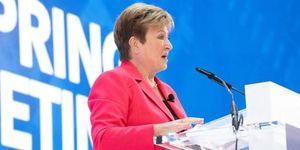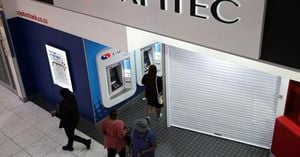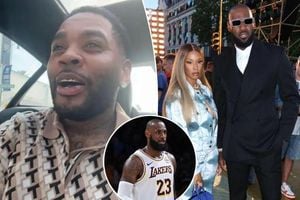As the US-China tariff tensions continue to escalate, a surprising new narrative is gaining traction not through official press conferences, but via viral TikTok and Instagram videos. Chinese factory workers and business owners have taken to the app to share behind-the-scenes glimpses into the world of luxury fashion manufacturing, claiming that many iconic high-end brands aren’t as European as they seem.
One widely circulated video posted by @senbags2 has garnered millions of views. In the clip, a man reveals that around 80% of luxury handbags are actually produced in China, even when the label says otherwise. “For over three decades, we’ve been the OEM [original equipment manufacturer] behind some of the biggest names - Gucci, Prada, Louis Vuitton,” he says. “But while we were the ones crafting these bags with precision, the profits were pocketed elsewhere. What I’m genuinely proud of is our quality, our skilled labour force, and our fully integrated supply chain.”
He goes on to address the changing geopolitical climate: “With Western nations attempting to cut ties with Chinese manufacturing, some brands tried relocating production. But they quickly realised that factories outside China couldn’t match our standards. Costs were higher, efficiency was lower, and infrastructure just wasn’t there. That’s why most luxury brands continue to rely on us, even if they don’t say it out loud. So why not buy directly from us?”
This claim has sparked renewed debate about transparency in luxury fashion, especially as customers continue to pay premium prices for goods they believe are hand-crafted in heritage ateliers across France and Italy. According to a 2023 Statista report, there are between 200 to 250 brands globally that fall under the “luxury” label. Of these, 70 to 100 are considered top-tier, enjoying elite status and commanding sky-high prices.
Traditionally, these brands promote their European roots, emphasising artisanal craftsmanship and heritage. Their official statements often list production hubs in Western Europe. Here’s a look at where some of the most renowned names in fashion say their bags are made:
- Hermès – France (notably in Paris and Pantin)
- Chanel – France (primarily Paris; some items in Italy)
- Louis Vuitton – France (Asnières and other workshops; also Spain and Italy)
- Gucci – Italy (mainly Tuscany and Florence)
- Prada – Italy (Tuscany and Milan)
- Dior – France (Paris ateliers, with some manufacturing in Italy)
- Bottega Veneta – Italy (Vicenza and the Veneto region)
- Fendi – Italy (Rome and Florence)
- Céline – Italy (Tuscany)
- Balenciaga – Italy and Spain
- Saint Laurent – France and Italy
- Givenchy – France and Italy
- Chloé – Italy (Tuscany)
- Valentino – Italy (Rome and Veneto)
- Burberry – Italy (for leather goods), with some UK production
- Loewe – Spain (Madrid and Barcelona)
- Goyard – France (Paris and Carignan)
- Miu Miu – Italy (under Prada’s umbrella)
- Bvlgari – Italy (Florence, for leather)
- Tom Ford – Italy (via high-end third-party manufacturers)
- Proenza Schouler – Italy (Tuscany and Veneto)
- Anya Hindmarch – Italy and UK (London for bespoke items)
- Mulberry – UK (Somerset) and Italy
- Salvatore Ferragamo – Italy (Florence and Tuscany)
- Stella McCartney – Italy (Tuscany, with a sustainable focus)
- Alexander McQueen – Italy (Florence and Tuscany)
- Loro Piana – Italy (Piedmont and Tuscany)
- Delvaux – Belgium (Brussels) and France
- Moynat – France (Paris ateliers)
- The Row – Italy (Tuscany)
While these brands maintain their European mystique, the online revelations suggest that at least some production may be outsourced to Chinese factories operating quietly behind the scenes. These manufacturers often work under non-disclosure agreements, preventing them from openly naming the brands they produce for. This new transparency—or at least the illusion of it—on TikTok is shifting consumer awareness.
As global shoppers become more savvy, many are starting to question what exactly they're paying for: the craftsmanship, the label, or just the prestige? The conversation also raises broader questions about the meaning of "Made in" labels and the ethics of luxury pricing. With Chinese OEMs now stepping forward to showcase their capabilities, the age of luxury secrecy might be giving way to a more open, if complicated truth.
In a parallel development, Chinese suppliers are leveraging social media to sell luxury items directly to Americans, offering prices drastically lower than US retail. As a trade war rages on, with US President Donald Trump’s relentless tariffs impacting trade, Chinese manufacturers are breaking the usual supply chain to reach out to customers directly.
Despite high tariffs, American TikTok users have found cheaper alternatives from Chinese manufacturers online. Users report their feeds are filled with videos of Chinese suppliers detailing high-quality products they make for luxury brands and offering them at a fraction of the cost without brand logos. One user on X shared a video of Chinese manufacturers selling Birkenstock footwear without the logo, stating, "My fyp is suddenly filled with Chinese manufacturers trying to sell directly to Americans. The gag is that even with paying the import tariff and shipping, it's still way cheaper than buying the same products through American corporations. We are not winning this trade war lmao."
From shoes to bags and even laundry detergent, videos filmed inside manufacturing units in China are taking over the social media feeds of Americans, who are finding deals too good to miss out on. The price of these items is so low that even with import duties and shipping costs, the total comes out to be less than half of what the product would cost in the US under a brand name. Some Chinese manufacturers are even offering to cover the shipping costs for buyers in the US and have filmed detailed videos showing the manufacturing process to dispel the myth that products made in China are of poor quality.
The US tariff on Chinese goods currently stands at a whopping 145 percent, with Beijing showing little inclination to back down by increasing its own retaliatory duties to 125 percent. This ongoing economic battle is reshaping the landscape of luxury goods, forcing consumers and brands alike to reconsider the implications of their purchasing choices.




